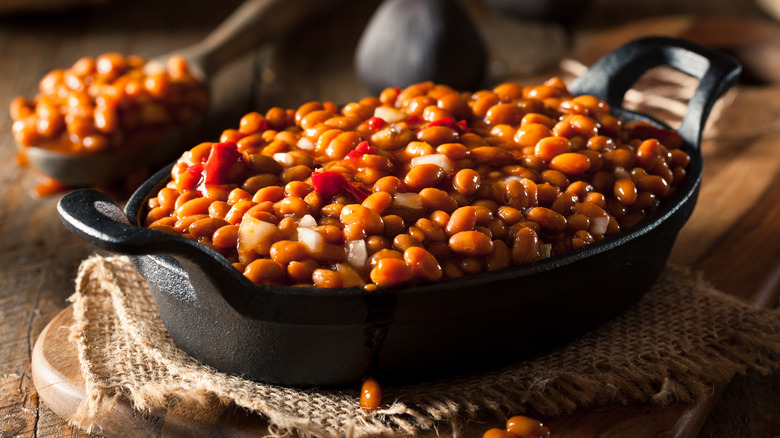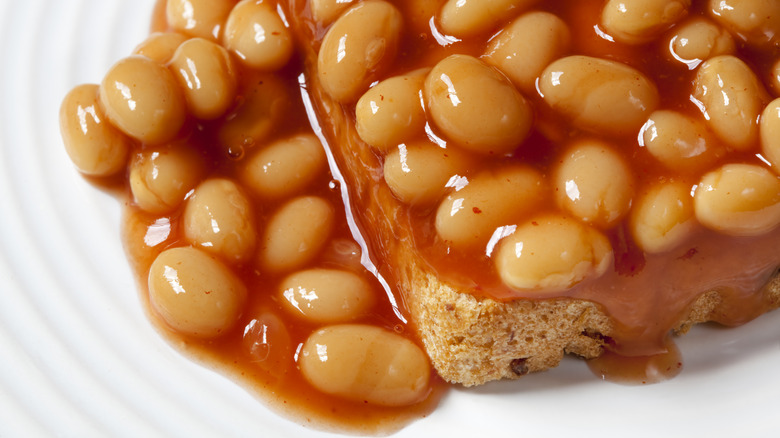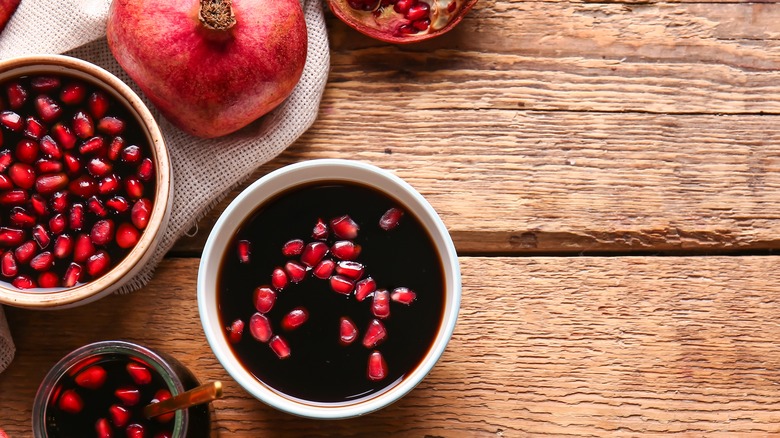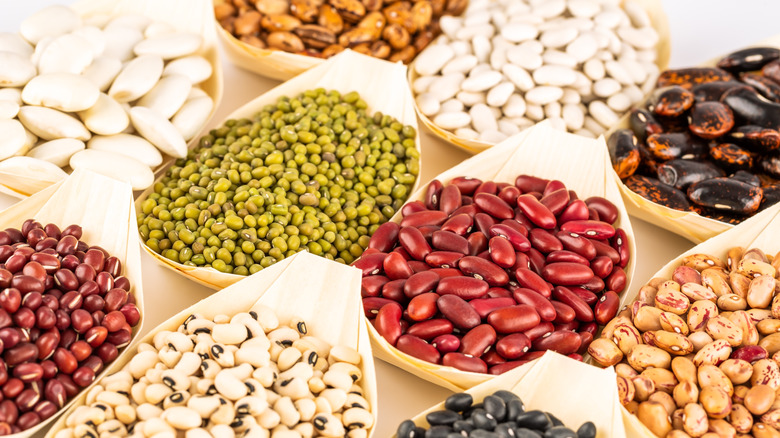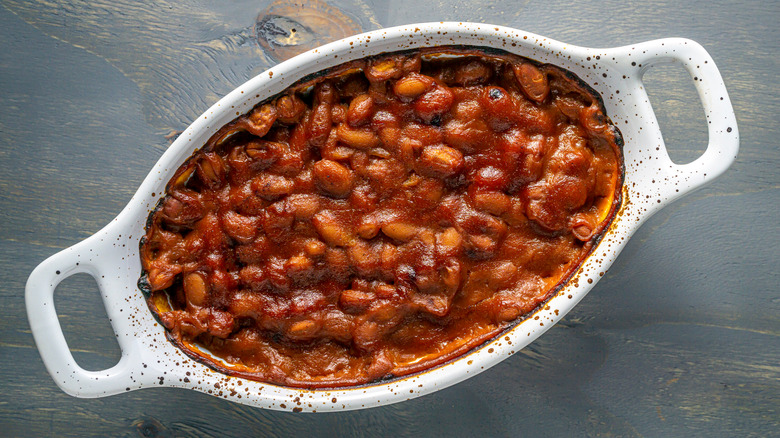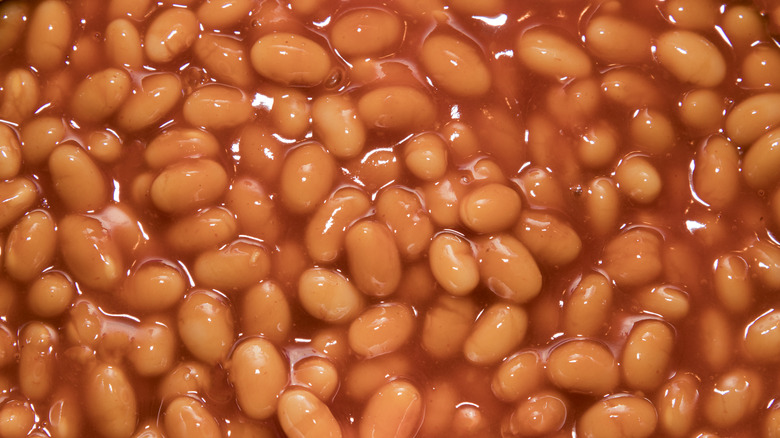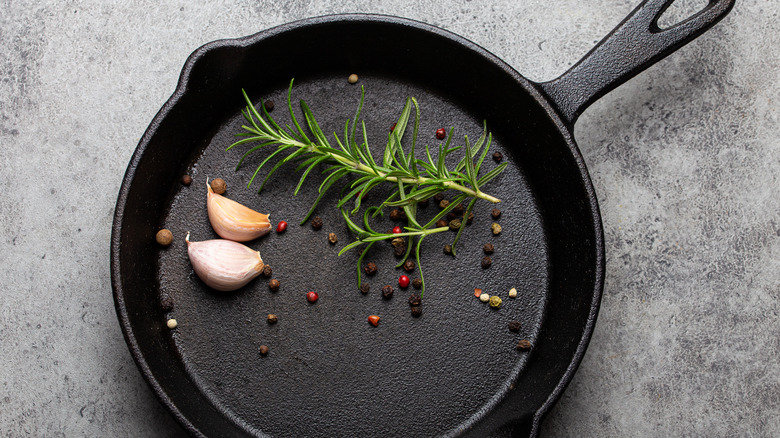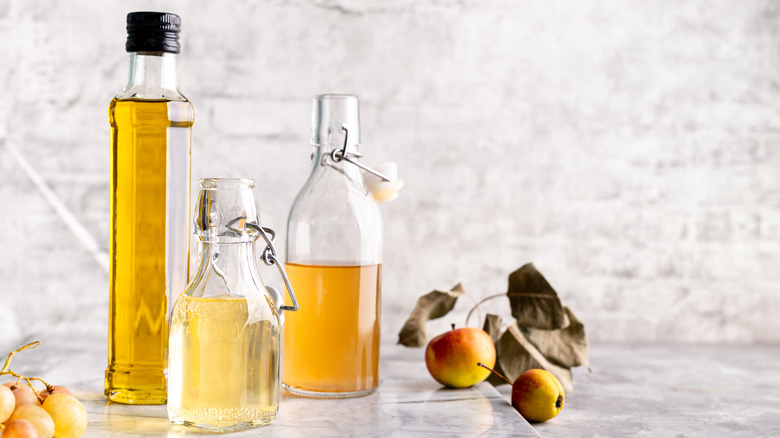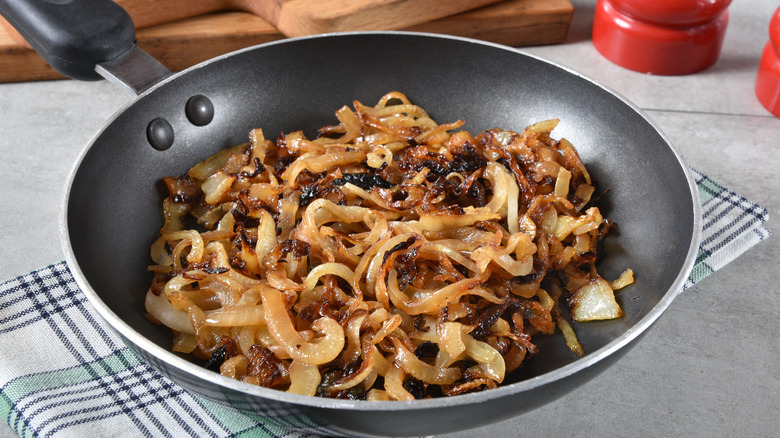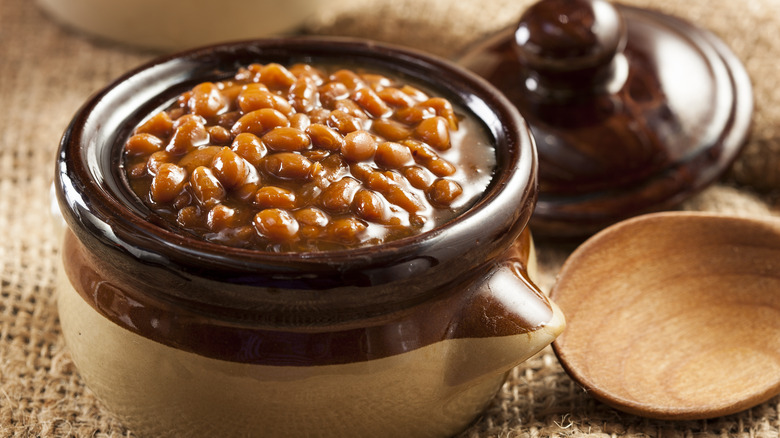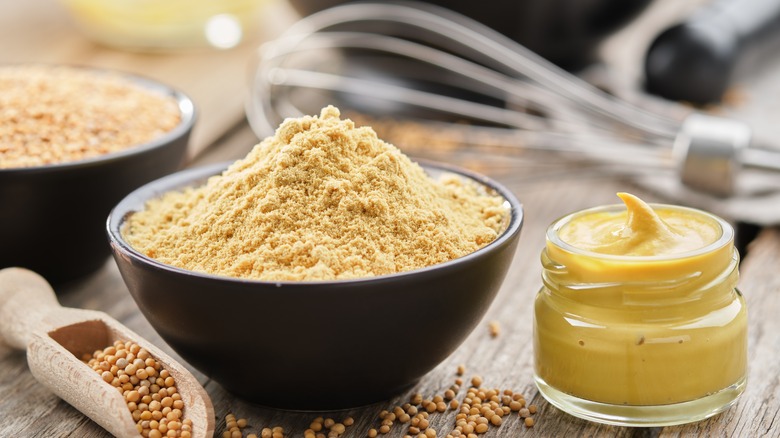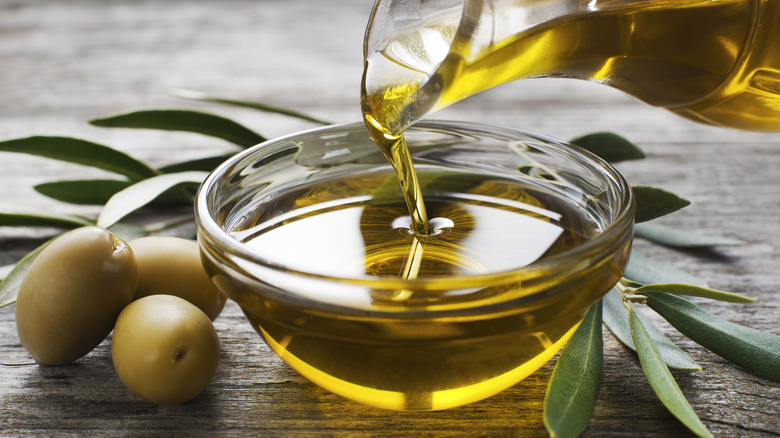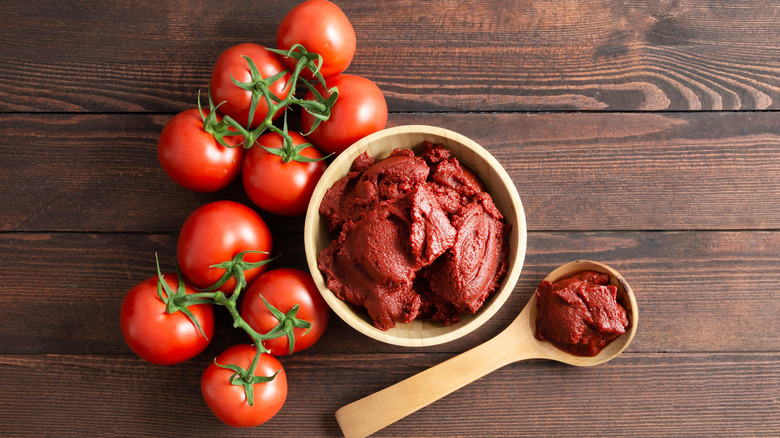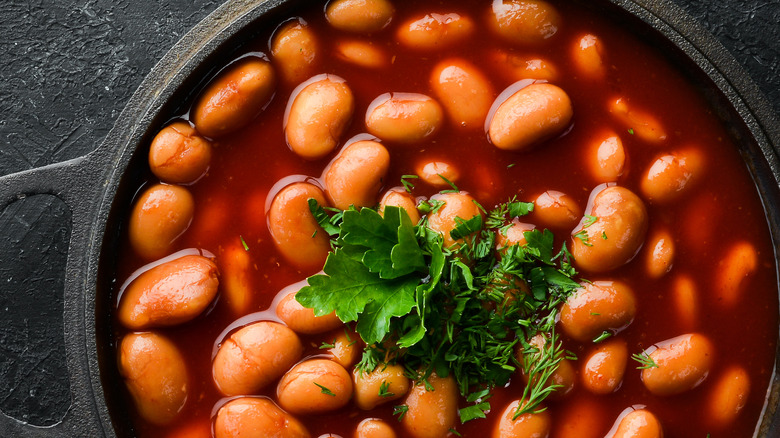14 Tips You Need When Making Baked Beans
Although the English are known for their famous baked bean breakfasts, the first creation of the dish actually took place in North America, thousands of years ago. Indigenous Americans used the "three sisters" of maize, beans, and squash to primarily sustain themselves, along with hunted and gathered foods like meats, berries, and seeds (per PBS). According to The Bean Institute, beans were one of the first foods to be cultivated by Native Americans, and it wasn't long before baked beans were invented. Beans were likely harvested and slow-cooked in stoneware and ceramics over an open flame for hours on end until they were tender and delicious.
Today, the tradition continues in New England and has spread down south and all over the world, with new variations on the classic cropping up all around. There are endless ways to make this popular dish, so we've gathered together the top 14 tips you need when making baked beans to keep things simple.
Whether you like your beans sticky and sweet alongside potato salad at a barbecue, or you prefer it thin and tomatoey over toast for breakfast, it's important to follow a few basic steps to ensure your beans come out just the way you like them. Let's get started.
Know your baked bean varieties
While you may have grown used to a primary style of baked beans, it's important to recognize that there are plenty of varieties out there to choose from. This may come as welcome news to those who have written off the side dish because it's too sweet or too tangy for their palate.
For instance, there is a subtle difference between Maine and Boston baked beans. Boston baked beans are typically made with navy beans or pea beans that have thin skin, while Maine baked beans use a thicker, starchier bean. Some varieties differ much more than just in texture. English baked beans tend to be thinner with more tomato sauce, while Southern baked beans are rich and often contain quite a bit of molasses and even bacon bits and fat. While English tinned baked beans are often eaten at breakfast time or on toast, the American version is typically found in a pile next to a hot dog or coleslaw.
Mix up your sweetener
It's easy to assume that anything sweet has been doused with plain old white sugar. And while many processed foods use corn syrup, beet sugar, or cane sugar, baked beans are distinguished by their unique sweetening methods. Using varied sweeteners can be an opportunity to add layers of flavor and richness to the recipe.
It's no secret that in most parts of the country, American baked beans have an intense sweetness to them. The ingredient that makes Boston baked beans so special is molasses, while Southern baked beans might use brown sugar. Even honey is popular when it comes to sweetening beans, and of course in New England, you can expect almost everything to be sweetened with maple syrup, especially in Vermont.
For those of you making baked beans at home for the first time, try brown sugar, maple syrup, or molasses. It's hard to go wrong with a classic, and you'll be sure to taste the difference.
Sweeten baked beans with fruit
Another method of sweetening baked beans is by adding fruit. Although fruit may not come to mind when thinking about this savory-sweet side dish, some people swear by this surprising addition. Just slapping any old fruit into the mix could be detrimental, so be strategic about which fruit pairs best with your sweetener of choice. Just add a subtle hint of fruit, as it should not overpower the tomato, but instead add an additional mild layer of flavor.
Try pairing a dark cherry blend or pomegranate juice with molasses, apple cider with maple syrup, or a hint of pineapple juice with brown sugar. Or use date syrup as your sweetener of choice by soaking and blending dates with water until it becomes a runny paste. Dates are loaded with fiber and nutrients and make for a healthy, whole-food alternative to refined sugars.
Luckily, dark fruits pair well with tomatoes, but beware of taking too much creative liberty when it comes to incorporating fruits into baked beans. We are not sure a banana baked bean recipe would be well received, but then again, we've never tried it (and hopefully never will).
Choose the right beans
Per Ontario Beans, there are over 400 types of beans out there to choose from. But when it comes to making baked beans, it's okay to be picky. Although different regions of the world tend to use different varieties of beans, the universally agreed upon go-to is navy beans. They are subtle in flavor, tender in texture, and absorb sauce beautifully. Navy beans can be found in both dried varieties or canned. When making baked beans from scratch, consider using dried beans. They have more structure to them and will absorb the sauce better than canned beans.
Bring dried beans to a boil, and let them simmer for about 45 minutes to hydrate them properly, or they can be soaked overnight. Consider using a few cups of sauce, or even vegetable broth, in the soaking process to penetrate the beans with as much flavor as possible. Once the beans become tender, drain them and mix your sauce right into the pot before deciding if you'd rather use an oven, slow cooker, or ceramic pot over your stovetop.
Slow cook your baked beans
Like any good thing, baked beans take time. It's important not to rush the process. If you were looking for a quick fix, you would have just sprung for the canned bean aisle in the grocery store.
Beans were originally cooked by Indigenous tribes in ceramic pots over an open flame, but today we have other options. Most people choose to bake their beans in the oven, which is perhaps the easiest method. There are possible downsides to using a slow cooker to make baked beans because slow cookers retain moisture, and it's important for the liquid in baked beans to cook off and reduce. While this method will produce delicately tender beans, the technique of cooking off the liquid is essential to producing rich and flavorful baked beans.
Leave beans uncovered while cooking them in the oven or on the stovetop in order to let the acids cook off and the tomatoes sweeten. No need to stir them or keep a close eye on your creation if you opt to bake them in the oven. When the buzzer goes off, they will be done.
Add the right amount of liquid to baked beans
Although it's critical that a great deal of liquid cooks off and that quite a bit gets absorbed into the beans, you want to make sure that you are adding the proper amount of liquid from the start. Even if the beans are hydrated overnight or with a boiling process, they will still absorb additional liquid. During the cooking process, much of the liquid and acid from the tomatoes will cook off, leaving behind a concentrated, sweet sauce. So, how much liquid should you use to make baked beans?
First of all, when you're soaking the beans it's less critical to use a perfect amount because you can always drain the excess. You do, however, want to be sure that you're using enough, so cover the beans with liquid and add a few extra inches just to be sure. Once you get down to cooking the beans in sauce, you'll want to ensure that your beans are swimming in it. Keep in mind that it will thicken during the baking process, so use enough liquid to just cover the beans.
Toast your spices
Have you ever walked into a kitchen and been overwhelmed by the intense aroma of spices swirling around? It's likely that whoever owns that kitchen knows a thing or two about spicing. The first rule is that every dish deserves more than just salt and pepper. The second rule is that it's always important to toast your spices, which is what gives them that intense aroma.
To awaken the flavor of herbs and spices, simply heat them in the pan until they are fragrant before adding liquid. This can be done with or without fat, like olive oil, and can happen alongside aromatics like garlic or onions. While it's important to keep them moving so they don't burn, this is an enjoyable process that shouldn't take more than a minute or so. Once the spices are nice and hot, their intensity has been released. It would be beneficial to toast your spices when you are cooking down those onions, before adding any tomato sauce or beans to ensure a full flavor.
Use spices like paprika, turmeric, onion powder, garlic powder, salt, and pepper. Sometimes spices like rosemary or thyme are added as well for additional flavor.
Include vinegar
Although tomato sauce has an element of acidity to it, it's important to add a little vinegar to give your baked beans that slightly tangy flavor. Even just a few tablespoons can make all the difference, and depending on the different types of vinegar you settle on, it can add depth and sweetness to the mix as well.
Apple cider vinegar is a classic and tastes delicious with any variety of baked beans. Consider using it with a lighter, English-style baked beans recipe. Because of its tangy, light flavor, it won't overpower the subtle tomatoey goodness that you've worked so hard to create.
On the other hand, for a rich and sticky-sweet Southern baked beans or Boston baked beans recipe, opt for a heavier vinegar like balsamic. It is rich in flavor, dark in color, and more intense than its apple-based counterpart.
Worcestershire sauce contains quite a bit of vinegar and has a serious depth of savory flavor. Keep in mind that Worcestershire sauce is not gluten-free or vegetarian, so using it may limit who can indulge in your tasty side dish.
Caramelize your onions first
Some like it sweet, and if that's the case for you, then load up on maple syrup, honey, brown sugar, or molasses. For English-style beans, additional sweeteners are not necessary. However, it's important to capitalize on the sweetness of the ingredients you are including, like tomatoes and onions. As cooking down tomato juice removes acid and naturally sweetens the sauce, the same thing happens with onions. Caramelizing onions is an important step that should not be overlooked when making homemade baked beans.
Follow a foolproof caramelized onion recipe. It takes very few ingredients, but you'll need a healthy dose of patience. Start by cooking your onions in broth until they are translucent. Allow the liquid to cook off and the onions to stick to the pan. Once they begin to brown, use more liquid to deglaze the pan before adding your garlic and spices.
By pre-cooking the onions, you are ensuring that they reach peak sweetness. Raw onions and garlic have a distinct flavor that works well in some recipes, but in the case of baked beans, the more you cook them, the better.
Chop up some pork
For all of those meat eaters out there, you may be used to enjoying baked beans that include pork. While English-style baked beans rarely include meat, many Southern-style baked beans, and even some New England baked beans, include a healthy dose of bacon, lard, or pork.
The addition of slab bacon, bacon fat, lard, or pork can add an element of fattiness and saltiness to your side dish. The inclusion of this decadent and rich ingredient works well with sweetened baked beans, and pairs beautifully with molasses and brown sugar. Bacon and maple syrup are a famous duo, so consider pairing them together.
The best type of pork for Boston baked beans is salt pork. Salt pork is a cut of pork from the animal's back that contains quite a bit of fat and is cured with — you guessed it — salt. Cook the pork right into the mixture, or fry up some bacon or lardons before adding them to the mix for a chewier, crispier texture with more flavor intensity.
Don't skimp on the Dijon
An often overlooked ingredient in baked beans just happens to be a condiment that most of us keep in our refrigerator at all times. Dijon mustard is often used in baked beans to add a hint of mild spice, along with flavors of vinegar and salt. It has a strong tang and sharp flavor. The heat of the mustard is mellowed out with the addition of vinegar, so for a spicier version, consider adding Dijon mustard powder instead, which is simply ground mustard seed.
It's especially important to include mustard in the American version of baked beans, but it can be included in English baked beans as well. Even though your side dish won't read as spicy, including just a little of the condiment can give your beans a subtle kick, and add a depth of flavor that will likely go undetected. While your guests might not be able to quite put their finger on it, adding Dijon can make all the difference.
Enhance their richness
While bacon fat adds an intensity of flavor and richness to the mix, not everyone eats meat or pork. To keep your side dish accessible to all, consider adding a hint of olive oil to your beans. Olive oil has an earthy, herbaceous, and fruity flavor. High-end extra virgin olive oil has a more intense flavor, while generic brands tend to be more subtle.
Technically, beans contain low levels of fat, so your dish won't be missing the fatty mouthfeel entirely if oil is excluded from the recipe. For English baked beans, the lack of fat may complement the lightness of the tomato sauce nicely. But for a rich, heavy, sweet, and thick American-style baked bean dish, fat is of great importance.
Olive oil adds richness, but you can also opt for butter. Butter has a saltier flavor, and pairs nicely with sweeteners like honey and brown sugar. Whichever route you decide to take, just a few tablespoons should do the trick.
Add tomato paste to your baked beans
While English-style baked beans are known for swimming in a lighter, thinner sauce, American-style baked beans are sweet, heavy, and rich. If your motto is "the richer the better," then consider adding tomato paste along with your tomato sauce. Tomato paste can give your sauce an umami flavor that adds an element of meaty depth. This savory flavor is often overlooked but can enhance a dish like baked beans with just a tablespoon or two.
Tomato paste is bitey, smooth, rich, and dense, and is simply tomatoes that have been cooked down into a paste. That's right, it is made from concentrated tomatoes and often comes in small jars or tubes. It's packaged like this because the truth is that you need very little of the ingredient to make a big impact on your dish.
For the ultimate, most umami baked beans of them all, consider using a few tablespoons of tomato paste in the mix.
Top with fresh herbs
Just because your baked beans are fresh out of the oven doesn't mean that they are done and ready to serve. Like many delicious side dishes, baked beans aren't winning any beauty contests. White beans floating in brownish-red sauce don't quite catch the eye, but that doesn't mean it doesn't taste absolutely incredible. Consider using fresh herbs as a garnish to brighten things up, and break up the heavy sweetness of the dish.
Freshly chopped parsley has a refreshing, citrusy, and peppery flavor. It is subtle enough that it tends to pair nicely with most savory dishes. Because it is so refreshing, it's often used to garnish heavier dishes like meats, mashed potatoes, or rich stews. It gives your palate a chance to rest and recover from the intensity of the dish and adds some variety. Even just a small sprig of the fresh herb can transform the whole look of your side.
